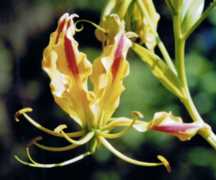‖interj. [ Sp., fr. L. ad to + deus god. Cf. Adieu. ] Adieu; farewell; good-by; -- chiefly used among Spanish-speaking people;
☞ This word is often pronounced but the Spanish accent, though weak, is on the final syllable. [ Webster 1913 Suppl. ]
n. [ Gr. &unr_; clear + &unr_; to observe. ] An instrument consisting in part of a differential thermometer. It is used for measuring changes of temperature produced by different conditions of the sky, as when clear or clouded. [ 1913 Webster ]
n. Same as Amnion. [ 1913 Webster ]
n.
n. [ Angio- + -scope. ] An instrument for examining the capillary vessels of animals and plants. Morin. [ 1913 Webster ]
n. [ Angio- + Gr. &unr_;, &unr_;, seed. ] (Bot.) A plant which has its seeds inclosed in a pericarp. Contrasted with
☞ The term is restricted to exogenous plants, and applied to one of the two grand divisions of these species, the other division including gymnosperms, or those which have naked seeds. The oak, apple, beech, etc., are angiosperms, while the pines, spruce, hemlock, and the allied varieties, are gymnosperms. [ 1913 Webster ]
a. (Bot.) Same as Angiospermous. [ 1913 Webster ]
a. (Bot.) Having seeds inclosed in a pod or other pericarp. [ 1913 Webster ]
a. [ Angio- + spore. ] (Bot.) Having spores contained in cells or thecæ, as in the case of some fungi. [ 1913 Webster ]
a. [ Angio- + Gr. &unr_; mouth. ] (Zool.) With a narrow mouth, as the shell of certain gastropods. [ 1913 Webster ]
‖n. [ Pref. arche- = archi- + Gr.
a. [ It. arioso, fr. aria. ] Characterized by melody, as distinguished from harmony. [ 1913 Webster ]
Mendelssohn wants the ariose beauty of Handel; vocal melody is not his forte; the interest of his airs is harmonic. Foreign Quart. Rev. [ 1913 Webster ]
‖adv. & a. [ It. ] (Mus.) In the smooth and melodious style of an air; ariose. [ 1913 Webster ]
‖n. [ NL.; Gr. &unr_; artery + sclerosis. ] (Med.) a chronic disease characterized by abnormal thickening and hardening of the walls of the arteries, esp. of the intima, occurring mostly in old age. Subtypes are distinguished, such as arteriolosclerosis and atherosclerosis. --
adj.
a. (Biol.) Relating to bacterioscopy;
n. (Biol.) One skilled in bacterioscopic examinations. [ 1913 Webster ]
n. [ Bacterium + -scopy; fr. Gr.
n. inhibition of the growth of bacteria, without outright killing of the organism. [ WordNet 1.5 +PJC ]
n. a chemical or biological material that inhibits bacterial growth. [ WordNet 1.5 ]
adj.
☞ Substances, such as antibiotics, which inhibit bacterial growth are usually classified as bacteriostatic or bacteriocidal depending on the rate at which bacteria exposed to the agents{ 4 } die. The rates of death of bacteria exposed to antibacterial agents{ 4 } are, however, dependent on the concentration of the agent{ 4 }, and form a continuum with some antibacterial agents{ 4 } of intermediate type. The penicillins are considered as typical bactericidal agents, and chloramphenicol or the sulfa drugs as typical bacteriostatic agents. In general, inhibitors of cell-wall synthesis will be bactericidal and many inhibitors of protein synthesis are classed as bacteriostatic, but some of the aminoglycosides also kill bacteria rapidly. [ PJC ]
n. [ Basidium + spore. ] (Bot.) A spore borne by a basidium. --
adj. of or pertaining to a basidiospore. [ WordNet 1.5 ]
n. [ Gr.
Bagman's Bioscope: Various Views of Men and Manners. [
n. [ Gr.
n. [ Gr.
n.
adj. of or pertaining to biosynthesis. [ WordNet 1.5 ]
adj. of or pertaining to biosystematics. [ WordNet 1.5 ]
n. use of data (e. g. cytogenetic or biochemical) to assess taxonomic relations esp within an evolutionary framework.
n. use of data (e. g. cytogenetic or biochemical) to assess taxonomic relations especially within an evolutionary framework.
a. [ Gr. &unr_; gill + &unr_; to cover: cf. F. branchiostège. ] (Anat.) Pertaining to the membrane covering the gills of fishes. --
☞ This term was formerly applied to a group of fishes having boneless branchiæ. But the arrangement was artificial, and has been rejected. [ 1913 Webster ]
(Anat.) The branchiostegal membrane. See Illustration in Appendix. [ 1913 Webster ]
a. (Anat.) Branchiostegal. [ 1913 Webster ]
‖n. [ NL., fr., Gr. &unr_; gill + &unr_; mouth. ] (Zool.) The lancelet. See Amphioxus. [ 1913 Webster ]
n. [ trademark. ] a type of antacid sold over-the-counter. [ WordNet 1.5 ]
‖a. [ It. ] (Mus) In a free, fantastic style. [ 1913 Webster ]
‖n. [ NL., fr. Gr.
prop. n. A genus of tendril-climbing herbs or shrubs whose seeds have a white heart-shaped spot.
n. A combination of cardiograph and sphygmograph. [ 1913 Webster ]
n. (Med.) Caries. [ 1913 Webster ]
n. (Med.) any of a group of infectious diseases caused by protozoan parasites (coccidia) of the order
n. One skilled in, or who practices, cranioscopy. [ 1913 Webster ]
It was found of equal dimension in a literary man whose skull puzzied the cranioscopists. Coleridge. [ 1913 Webster ]
n. [ Cranium + -scopy. ] Scientific examination of the cranium. [ 1913 Webster ]
‖n. [ Gr.
n.;
When thou wast in thy gilt and thy perfume, they mocked thee for too much curiosity. Shak. [ 1913 Webster ]
A screen accurately cut in tapiary work . . . with great curiosity. Evelin. [ 1913 Webster ]
We took a ramble together to see the curiosities of this great town. Addison. [ 1913 Webster ]
There hath been practiced also a curiosity, to set a tree upon the north side of a wall, and, at a little hieght, to draw it through the wall, etc. Bacon. [ 1913 Webster ]
‖n.;
‖n. [ NL. Named after
n.
